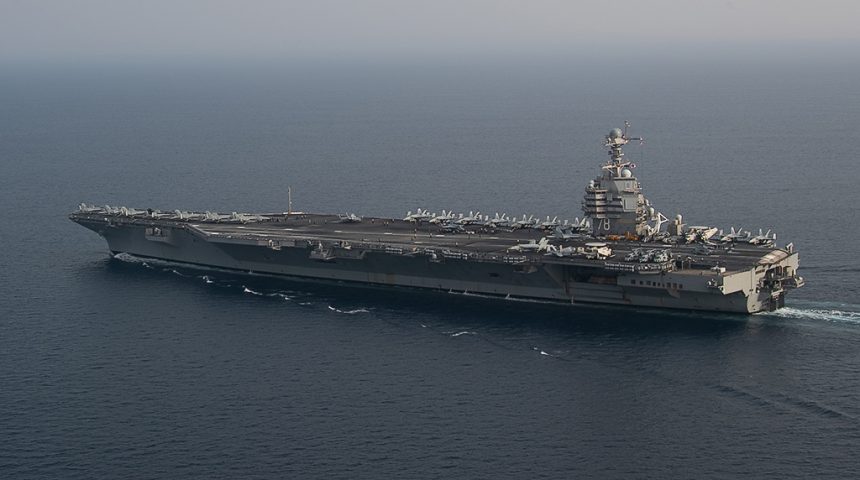The U.S. is considering deploying USS Eisenhower along USS Ford in the eastern Mediterranean Sea, in what would be a massive show of force.
Following the Hamas attack on Israel, the U.S. Defense Secretary Lloyd Austin ordered USS Gerald Ford aircraft carrier to set sail to the Eastern Mediterranean to be ready to assist Israel. The largest warship in the world, and the US Navy’s newest and most technologically advanced aircraft carrier is not alone: part of the Gerald R. Ford Carrier Strike Group (GRFCSG) are also the Ticonderoga-class guided missile cruiser USS Normandy (CG 60), as well as the Arleigh-Burke-class guided missile destroyers USS Thomas Hudner (DDG 116), USS Ramage (DDG 61), USS Carney (DDG 64), and USS Roosevelt (DDG 80).
The Norfolk, Virginia-based GRFCSG was already in the Mediterranean, heading towards Marseille when the order to reposition off Israel was dispatched. Last week USS Ford conducted joint exercises with the Italian Navy ITS Cavour in the Ionian Sea.
The purpose of the deployment is to provide support to Israel as well as deter “Iran, Lebanese Hezbollah, and any other proxy across the region who might be considering exploiting the current situation to escalate the conflict,” as a senior defense official told reporters on Monday.
Commissioned in 2017, the USS Gerald R. Ford (CVN-78) is the first ship in this new class of nuclear-powered aircraft carriers for the U.S. Navy. It is the first major redesign of U.S. aircraft carriers in 42 years. Among a long list of new engineering features on board USS Gerald R. Ford are the controversial electromagnetic catapults and arresting gear, a new, smaller, lower radar cross section island structure, larger and more efficient flight deck facilitating faster aircraft launching, more than twice the electrical power of previous carrier classes and a more efficient crew compliment with 500 fewer personnel on board. The massive 1,106-foot-long carrier displaces a staggering 100,000 tons fully loaded and is powered by two new generation nuclear reactors.
#USSGeraldRFord Sailors are prepared and ready for anything, at any time. #ProudToServe #AlwaysReady
@usnavyeuropeafrica @usnavy pic.twitter.com/qMDtMp5PXk
— USS Gerald R. Ford (CVN 78) (@Warship_78) October 9, 2023
Around 70 aircraft are embarked on USS Gerald Ford as part of CVW-8 that includes F/A-18E and F Super Hornets of VFA-37, VFA-213, VFA-31 and VFA-87, along with EA-18G Growlers of VAQ-142, E-2Ds of VAW-124 and MH-60S and MH-60R helicopters respectively of of HSC-9 and HSM-70.
Current location of the U.S. Navy’s (🇺🇸) USS Gerald R. Ford aircraft carrier based on helicopter tracks. https://t.co/QXHSlLiPiA pic.twitter.com/9qsC6saNGC
— Aerospace Intelligence (@space_osint) October 10, 2023
Needless to say, the variety of aircraft allows the Air Wing to carry out all types of required attack or air defense mission, airspace control, SEAD, Electronic Attack as well as support in various ways, a possible evacuation of US nationals from Israel. The aircraft carrier has always been the most flexible and powerful tool in the hands of the U.S. decision makers. Do you remember the famous: “Where are the carriers?”. It’s the question Tom Clancy mentions introducing his book “Carrier” in 1998 borrowing it from many US Presidents as they asked it whenever an international crisis involving US interests broke out in any part of the world. When prompt intervention is required, an aircraft carrier is called in.
As if one carrier was not enough to calm down the tensions in the region, the Pentagon may soon move another supercarrier in the eastern Med waters: USS Dwight D. Eisenhower (CVN-69). The “Ike” was already scheduled to visit the Middle East area of operations, but the U.S. are currently weighting whether to also send its carrier strike group off Israel and the Gaza Strip. It is not clear whether the Eisenhower would replace the Ford or whether both aircraft carriers would remain in the area in what would be a massive show of force.
We will see.








